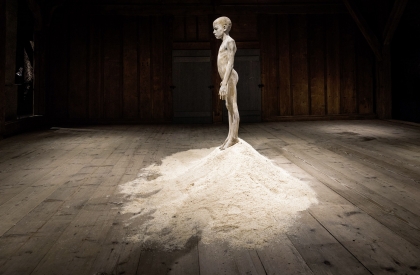
As Bruno Walpoth’s exhibition Mute Encounters in CAFA Art Museum (CAFAM) began in March, the artist himself gave a lecture at the lecture hall at CAFAM. The lecture was presented by Professor Lv Pinchang, director of the Department of Sculpture at CAFA. Professor Zhang Wei and Professor Xiao Li at CAFA also joined a dialogue with Mr. Walpoth after his speech.

Mr. Bruno Walpoth
Mr. Walpoth began his lecture by introducing his hometown Gröden, a fascinating mountain village surrounded by Dolomite Mountains in northern Italy and adjacent to Austria. The village is known for its wood sculpture tradition, from the earliest religious wood sculpture to the later developed wood toy industry that accept orders from the whole Europe.

Mr. Walpoth's hometown
Mr. Walpoth was born into a family of wood sculptors. From 19th to mid-20th century, religious wood sculpture gradually became an art form. A specialized wood sculpture school was also founded during that time. The religious wood sculptures were created in special studios, used by artisans who pass on their skills from generation to generation. Mr Walpoth’s grandfather and uncle were both wood sculptors. Of course, Bruno Walpoth also grew up and apprenticed in one of these studios. Uninterested in religious sculpture, Mr. Walpoth went to study at the Akademie der Bildenden Künste München in Germany.

Bruno Walpoth's uncle
During his years there, Mr. Walpoth avoided using wood as sculpting material deliberately, but three years later he realized he must go back to wood. In 1980s, realistic works was outdated. It was abstract art or conceptual art that was popular, but Mr. Walpoth’s professor encouraged him to carry on his pursuit in figurative art, as the trend will return one day.

In the end of his speech, Mr. Walpoth shared his two biggest inspirations with the audience: one is the art period from the Medieval time to the early Renaissance. He showed the audience picture of a bust by a sculptor from that time. He was lesser known than masters like Michelangelo and Da Vinci, but he had greater influence on Mr. Walpoth; the other is Antonello da Messina’s paintings, from which Mr. Walpoth could feel great spiritual impact.

Mr. Walpoth concluded his speech by showing pictures of his works, along with background music created by his son, who was also present at the lecture hall.
After the lecture, Mr. Walpoth had a dialogue with Prof. Lv Pinchang, Prof. Zhang Wei and Prof. Xiao Li on the stage. Prof. Zhang said he was deeply touched by Mr. Walpoth’s sharing, because as a professor of Department of Sculpture, he saw a lot of students and teachers thinking of sculpting bodies as a commonplace and basic training. But in fact, it is not enough to just learn some techniques or modeling skills from the practice, and it is even wrong to only pursue a different visual appearance.
Mr. Walpoth replied by praising CAFA’s Department of Sculpture. He visited the department one day before the lecture, and recalled his youth time as he saw students practicing sculpting with human figures. It was how they used to study sculpture, but many fine art academies in Europe today have abandoned this tradition. On the other hand, Mr. Walpoth saw a trend that today’s students have the wish of going back to realistic traditions.
Mr. Walpoth added that the study of body figures and forms are utterly important to him, and raised his expression to an unprecedented level. However, he also warned that it is his personal path, and every artist should have his or her own path, and find his or her own language out of their inner pursuit. It is meaningless to blindly follow any trend.

Mr. Zhang also asked a question for sculpture students - while it is within reason to either meticulously or coarsely make a sculpture, how should one grasp the sense of propriety?
Mr. Walpoth responded by sharing his own experience, noting that the key to judging a good work is not its details, but the emotions the sculptor wants the work to express. It is important for a sculptor to decide when to stop sculpting. He believes that the best working status is when he can’t feel the time passing.
Regarding the white pigments he stained his work, Mr. Walpoth revealed that the whiteness will completely change the sculpture’s expressivity, bringing a completely new perspective to him - absolutely different from the work he observed during sculpting. That’s how he could jump out of his stereotype and re-examine his work.
Time: March 7, 2019
Venue: Lecture Hall, CAFA Art Museum
Speaker: Bruno Walpoth
Presenter: Prof. Lv Pinchang, Director of the Department of Sculpture, CAFA
Guests: Prof. Zhang Wei at CAFA, Prof. Xiao Li at CAFA
| Lecture Photos |




2019-03-05~2019-05-04
